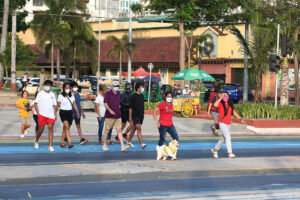THE PHILIPPINES has detected its first two cases of the Omicron subvariant BA.2.75, according to the Department of Health.
The two patients infected with the variant called Centaurus came from the Western Visayas, Health officer-in-charge Maria Rosario S. Vergeire told a news briefing on Tuesday. Both have recovered, she added.
“The exposure of individuals, travel histories and health status are being verified,” she said, adding that one of the two patients was unvaccinated while the other had been partially inoculated.
The highly infectious BA.2.75 has been detected in several countries. Scientists still do not know how severe it is, Ms. Vergeire said.
She said the Philippine infection rate for COVID-19 had risen to 16.7%, way above the World Health Organization’s ideal threshold of 5%.
Still, the country remains at low risk from the coronavirus, she said. “Nationally, we are still at low-risk classification with a daily average attack rate of 2.9 cases per 100,000 population.”
The capital region remains at moderate risk from the virus, with a daily average daily attack rate of 8.16 cases per 100,000 population.
Ms. Vergeire said 1,015 more BA.5 cases had also been detected in all regions except in the Zamboanga Peninsula and Northern Mindanao. Three returning overseas Filipinos also tested for the subvariant, she added.
Of the new BA.5 cases, 883 have recovered, while 84 were still in isolation. The status of the remaining 48 cases were still being verified.
Ms. Vergeire said there were also 26 new BA.4 patients, six of whom came from Metro Manila, four from Cagayan Valley, three from Western Visayas, two each from Central Luzon, Calabarzon, Bicol, Davao, Soccsksargen and the Cordillera Administrative Region, and one from the Ilocos region.
Twenty-one of the BA.4 patients have been recovered, while two were still in isolation, Ms. Vergeire said.
Meanwhile, 18 more patients have been infected with the BA.2.12.1 subvariant, five of whom came from Metro Manila, three each from the Ilocos and Cordillera regions, two each from Western Visayas, Central Visayas, and Calabarzon and one from Cagayan Valley.
Thirteen of the new BA.2.12.1 patients have already recovered, while four were still in isolation.
The exposures and travel histories of all the newly detected cases of Omicron subvariants were still being verified, Ms. Vergeire said.
Aside from COVID-19, the country is also facing threats from dengue, Ms. Vergeire said, with cases having more than doubled to 82,597 as of July 16. She said 20,261 cases were recorded from June 19 to July 16.
Most dengue cases were recorded in Central Luzon at 13,449, Central Visayas at 8,905 and the National Capital Region at 6,884, Ms. Vergeire said.
She said 10 of 17 regions have exceeded the epidemic threshold in the past four weeks, with Cagayan Valley, the Cordillera Administrative Region and Mimaropa having experienced an increase in cases.
In a statement, the DoH said 319 dengue-related deaths nationwide have been reported so far, 32 of which occurred in July and 72 in June.
The agency said hospitals and clinics have fast lanes for dengue patients in their emergency areas “for prompt diagnosis and management of cases.” — Kyle Aristophere T. Atienza

